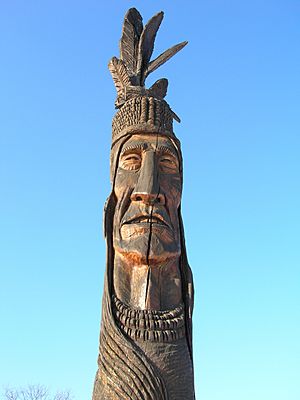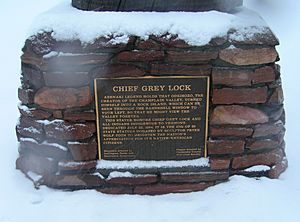Gray Lock facts for kids
Gray Lock (also known as Greylock) was a brave and clever leader of the Abenaki people. His original name was Wawanotewat. He was born around 1670 in what is now Westfield, Massachusetts. Gray Lock became a very important chief for the Missisquoi Abenaki band, and his family has continued to lead them even today. He was known as a strong leader for the Waranoak people, who were the first inhabitants of the central Connecticut River Valley in New England.
Gray Lock's War: A Fight for Land
The mid-1720s saw a conflict called Dummer's War. It was also known as Greylock's War or the Three Years War. This war involved many battles and raids between English colonists and groups from the Wabanaki Confederacy. Chief Gray Lock became famous during this time. He organized Native resistance from areas like Otter Creek and the Missisquoi in what is now Vermont.
French explorers like Samuel Champlain first explored the Kennebec River area in Maine in 1604. They claimed the land for France. Soon after, English colonists began settling on lands along the Kennebec River. These lands had been used by the Abenaki people for a long time. The Abenaki considered these lands their own. As more English settlements appeared, the French and Abenaki formed an alliance against them.
Tensions grew and led to open fighting in 1722. Abenaki war parties began raiding English settlements. These raids stretched from coastal Maine to Lake Champlain. Gray Lock quickly became the main Abenaki military leader. He led many successful guerrilla raids in areas that are now southern Vermont and western Massachusetts. He was very good at avoiding his pursuers. Because of this, his warrior name became Wawanolet, which means "he who fools the others."
In August 1723, Gray Lock led a war party that attacked English settlements. They raided Northfield and Rutland, taking some settlers captive. The English colonial militia was put on high alert. But in October, Gray Lock attacked Northfield again and escaped safely. More settler troops were then sent out. In early 1724, the Massachusetts Bay Colony built a fort called Fort Dummer. This fort was built on the west bank of the Connecticut River, near today's Brattleboro, Vermont. It was meant to help protect against future attacks. The colonial garrisons at Northfield were also made stronger. This pushed the Abenaki out of their traditional winter hunting grounds.
The last of these settler groups left the field in March and April 1725. Gray Lock's group then left their winter camps, causing alarm in the settlements again. Captain Benjamin Wright set out in July to get revenge. He went to Missisquoi with new recruits. But they did not have enough supplies, so they turned back. Gray Lock followed Wright all the way to Northfield. Skirmishes and alarms continued around Fort Dummer and Deerfield for the rest of the summer.
Eastern Abenaki groups made peace with Massachusetts in 1725 and 1726. Abenaki bands in Canada also agreed to peace terms in 1727. But Gray Lock refused to make peace. He continued to lead occasional raids on the colonies for about twenty more years. Records show that Gray Lock died a free man around 1750. His name was already a legend, even among his enemies. He died surrounded by his family and loyal followers.
Gray Lock's Lasting Legacy
Mount Greylock in Western Massachusetts is believed to be named after Chief Gray Lock. It is not clear if he was ever personally connected to this mountain. However, the name "Mount Greylock" first appeared in print around 1819. It became widely used by the 1830s.
There is also a monument and a plaque dedicated to Chief Gray Lock. You can find it in Battery Park (Burlington, Vermont).
Family Leaders
- Jean-Paul Nolet (born Wawanoloath)
- Alexis Wawanoloath
- Christine Sioui-Wawanoloath
- Monique Sioui



